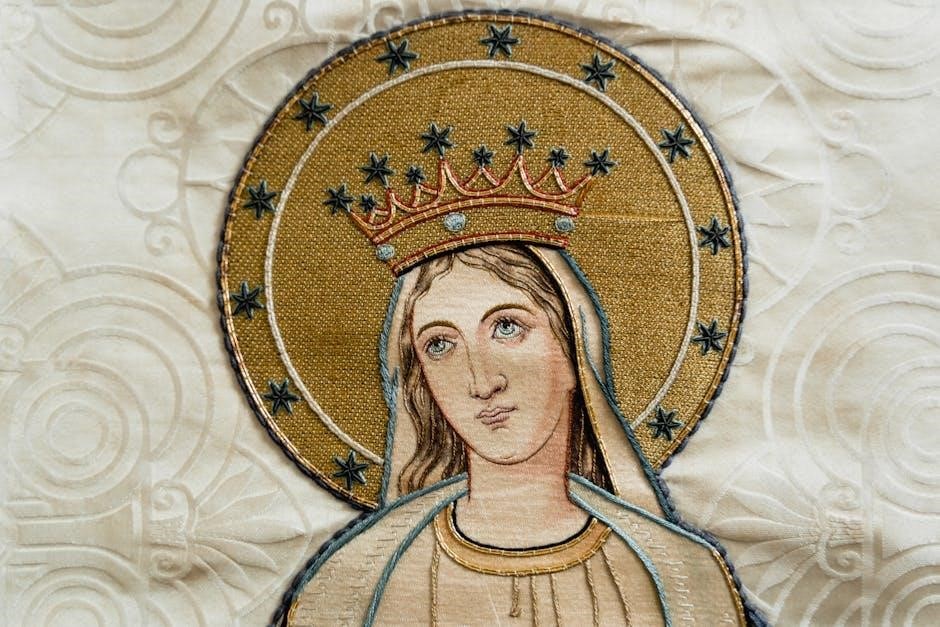The Gospel of Mary is a significant early Christian text, discovered in the 20th century, offering unique insights into Mary Magdalene’s role and spiritual visions. It emphasizes women’s leadership and gnosis, contrasting with canonical gospels. The PDF version provides accessible reading, highlighting its relevance in modern scholarship and feminist theology.
1.1 Discovery and Historical Significance
The Gospel of Mary was discovered in the 20th century, shedding light on early Christian traditions. Originally written in Greek during the 2nd century, it explores Mary Magdalene’s visionary experiences and her role as a spiritual leader. The text challenges traditional hierarchies, emphasizing women’s authority and gnosis. Its discovery has significantly influenced biblical scholarship, offering a unique perspective on early Christianity. The PDF version of the Gospel of Mary is widely available, allowing readers to access this important text easily. It remains a vital resource for understanding the diverse theological currents of the early Christian era.
1.2 Key Themes and Messages
The Gospel of Mary highlights Mary Magdalene’s prominence as a spiritual leader and visionary. It explores themes of revelation, the soul’s journey, and the nature of the divine. Unlike canonical gospels, it emphasizes Mary’s role in receiving and interpreting divine visions, challenging patriarchal norms. The text also delves into Gnostic ideas, such as the ascent of the soul through spiritual knowledge. Its messages promote equality and the empowerment of women in early Christianity, offering a unique perspective on discipleship and faith. These themes resonate strongly in modern feminist and theological studies, making the PDF version of the Gospel of Mary a valuable resource for exploring alternative Christian traditions.
1.3 Availability in PDF Format
The Gospel of Mary PDF is widely available for download and reading online, providing easy access to this important text. Platforms like PDFDrive and the Internet Archive offer free downloads in PDF and text formats. This accessibility has made the document a popular resource for scholars and enthusiasts alike. The PDF version includes the full text of the Gospel, along with introductory notes and historical context. It is compatible with various devices, allowing readers to engage with the material anywhere. The digital format ensures that the Gospel of Mary remains relevant and accessible in the modern age, fostering deeper understanding of its themes and significance in early Christian history.

Historical Background of the Gospel of Mary
The Gospel of Mary, dated to the 2nd century, reflects early Christian and Gnostic traditions. Discovered in Egypt in 1896, it remains a significant historical text.
2.1 Composition and Date
The Gospel of Mary is believed to have been composed in the early 2nd century, likely between 100-150 AD. It reflects Gnostic influences and early Christian traditions. The text, originally written in Greek, survives primarily through Coptic manuscripts from the 3rd century. Its discovery in 1896 in Egypt provided crucial insights into early Christian diversity. The Gospel of Mary is distinct from the canonical gospels, offering unique perspectives on spirituality and discipleship. Its composition predates many surviving Christian texts, making it a valuable historical document for understanding the development of Christianity and Gnosticism. This text remains a fascinating piece of religious history.
2.2 Language and Manuscript Tradition
The Gospel of Mary was originally written in Greek, with the earliest surviving manuscripts in Coptic, dating to the 3rd century. These manuscripts are fragmented, with significant portions missing or damaged. The most complete version is found in the Berlin Codex, while other fragments exist in the Papyrus Rylands 463. The text reflects a Gnostic theological perspective, emphasizing spiritual knowledge and the soul’s journey. Despite its fragmented state, the manuscript tradition highlights the Gospel of Mary’s importance in early Christian communities. The language and style suggest a sophisticated literary composition, blending theological discourse with narrative elements. Its survival in multiple manuscripts underscores its influence and enduring relevance in early Christian thought.

Content and Structure of the Gospel of Mary
The Gospel of Mary presents a unique narrative, blending dialogue and visionary elements. It recounts Jesus’ appearance to Mary Magdalene, her spiritual vision, and the disciples’ responses, offering profound theological insights while emphasizing Mary’s leadership role among the early followers of Jesus.
3.1 Jesus’ Appearance to Mary Magdalene
In the Gospel of Mary, Jesus appears to Mary Magdalene after his resurrection, entrusting her with divine revelations. This encounter highlights Mary’s unique role as a spiritual leader and a favored disciple. Jesus commissions her to spread his teachings, emphasizing her authority among the apostles. The narrative underscores Mary’s emotional depth, as she mourns Jesus’ departure but finds strength in her spiritual mission. This appearance is central to the text, positioning Mary as a key figure in early Christian tradition and challenging traditional hierarchical views of leadership. The PDF version of the Gospel of Mary captures this pivotal moment, offering readers insight into Mary’s transformative experience and her enduring legacy.
3.2 Mary’s Vision and Spiritual Revelation
Mary’s vision in the Gospel of Mary PDF reveals a profound spiritual experience, where she encounters a divine being who imparts esoteric knowledge. This revelation transcends physical reality, focusing on the soul’s journey and liberation from material constraints. The vision emphasizes gnosis, or spiritual insight, as the path to salvation. Mary’s ability to receive such revelations underscores her spiritual authority, positioning her as a leader among the disciples. The text’s mystical tone contrasts with the more literal accounts in canonical gospels, highlighting the Gnostic influence. The PDF version preserves the vivid imagery and theological depth of Mary’s vision, offering readers a window into early Christian mysticism and the feminine divine. Her revelation becomes a cornerstone of the narrative, shaping its theological message.
3.3 The Role of Peter and Other Disciples
In the Gospel of Mary PDF, Peter is portrayed as a key figure among the disciples, yet his role is complex and often conflicted. He expresses skepticism toward Mary’s vision, questioning her credibility and the validity of her spiritual experience. This dynamic highlights tensions within the early Christian community regarding leadership and authority. Other disciples, such as Andrew and Levi, also play significant roles, with Levi defending Mary and affirming her spiritual insight. The text underscores the disciples’ struggle to comprehend the mystical teachings Mary shares, revealing their limited understanding of Jesus’ true message. This section contrasts Peter’s doubt with Mary’s faith, emphasizing the theological themes of gnosis and the soul’s liberation. The PDF version captures these interactions vividly, illustrating the human and theological dimensions of the narrative.

Theological Themes in the Gospel of Mary
The Gospel of Mary PDF explores themes of gnosis, the soul’s journey, and the nature of the divine, challenging materialism and emphasizing inner spiritual truth.
4.1 The Role of Women in Early Christianity
The Gospel of Mary PDF highlights Mary Magdalene as a prominent leader and apostle, challenging the patriarchal norms of early Christianity. She receives divine visions and teachings directly from Jesus, emphasizing her spiritual authority. This text portrays Mary as a key figure in spreading Jesus’ message, often surpassing the understanding of male disciples. Her role underscores the importance of women in early Christian communities, offering a counter-narrative to the dominant male-centered accounts. The Gospel of Mary thus provides valuable insights into the diverse roles women played in the early church, which were often overlooked in later traditions. This perspective is particularly significant for modern discussions on gender equality and religious leadership.
4.2 The Concept of the Soul and Gnosis
The Gospel of Mary PDF explores the Gnostic understanding of the soul and its journey toward liberation. According to the text, the soul must transcend the material world and its illusions to achieve spiritual enlightenment, or gnosis. Mary Magdalene receives a vision from Jesus, detailing the soul’s ascent through cosmic realms, emphasizing the importance of spiritual knowledge over physical existence. This reflects the Gnostic belief that salvation comes through self-awareness and divine insight, rather than external rituals. The Gospel of Mary thus presents a mystical path to enlightenment, where the soul’s liberation is the ultimate goal. This theme aligns with broader Gnostic teachings, offering a unique perspective on spirituality and human destiny.

The Role of Mary Magdalene

Mary Magdalene emerges as a prominent spiritual leader in the Gospel of Mary PDF, known for her visionary insights and unwavering faith in Jesus’ teachings.

5.1 Mary as a Leader and Apostle
In the Gospel of Mary PDF, Mary Magdalene is depicted as a visionary leader and apostle, entrusted with sacred teachings from Jesus. Her role transcends traditional gender norms, as she emerges as a central figure in spreading Jesus’ message. The text portrays her as courageous and spiritually discerning, capable of comforting the grieving disciples and sharing revelations that deepen their understanding of the divine. Unlike Peter, who doubts her vision, Mary embodies faith and resilience, solidifying her position as a key apostle. This portrayal challenges patriarchal norms and highlights her spiritual authority, making her a symbol of female leadership in early Christianity. The Gospel of Mary PDF thus underscores her pivotal role in the early Christian movement, offering a unique perspective on her apostolic mission.
5.2 The Debate Over Mary’s Authority
The Gospel of Mary PDF highlights a significant debate over Mary Magdalene’s authority among the disciples. Peter questions her credibility, expressing doubt about her vision of Jesus, which sparks tension within the group. This conflict reflects broader disputes in early Christianity regarding women’s roles in leadership. Mary’s ability to receive divine revelations challenges the patriarchal norms of the time, positioning her as a figure of spiritual authority. The text emphasizes her resilience and unwavering faith, countering Peter’s skepticism. This debate underscores the struggles of female leadership in the early church and aligns with modern discussions about gender equality in religious contexts. The Gospel of Mary PDF thus offers a compelling narrative of authority, faith, and gender dynamics.

Comparisons with Other Gospels
The Gospel of Mary differs from canonical gospels in its focus on Mary Magdalene and Gnostic themes, aligning more with texts emphasizing spiritual enlightenment and the soul’s ascension.
6.1 Differences from the Canonical Gospels
The Gospel of Mary contrasts sharply with the canonical gospels in its portrayal of Mary Magdalene as a central figure and leader. Unlike the New Testament gospels, which focus on the Twelve Apostles and Jesus’ ministry, the Gospel of Mary emphasizes Mary’s spiritual authority and visionary experiences. It lacks narratives about Jesus’ life, miracles, or resurrection, instead focusing on his post-resurrection teachings and Mary’s role in spreading his message. The text also diverges in its Gnostic theological themes, such as the emphasis on the soul’s ascent and the rejection of materialism, which are absent in the canonical accounts. This makes it a unique and controversial text within early Christian literature.
6.2 Similarities with Gnostic Texts
The Gospel of Mary shares significant similarities with Gnostic texts, particularly in its emphasis on secret knowledge (gnosis) and the soul’s journey to enlightenment. Like other Gnostic works, it portrays the material world as flawed and emphasizes the importance of spiritual insight over physical resurrection. The text also features dualistic themes, contrasting the divine realm with the inferior material world. Mary’s role as a recipient of revelation aligns with Gnostic narratives, where female figures often serve as conduits of divine truth. The focus on individual spiritual experience and the rejection of hierarchical authority further connects it to Gnostic traditions, making it a key text in understanding early Christian Gnosticism.

Modern Interpretations and Relevance
The Gospel of Mary offers modern insights into early Christianity’s diversity, challenging traditional narratives and inspiring contemporary spiritual and feminist inquiries globally.
7.1 Feminist Perspectives on the Gospel of Mary
Feminist scholars emphasize Mary Magdalene’s prominence in the Gospel of Mary, challenging patriarchal narratives that marginalized her role in early Christianity. Her leadership and spiritual authority, as depicted in the text, resonate deeply with modern feminist theology. The Gospel of Mary PDF highlights her unique vision and teachings, showcasing her as a key apostle and a figure of spiritual insight. This perspective counters traditional interpretations that often diminished her influence. Feminist interpretations celebrate Mary as a symbol of female empowerment and religious equality, offering a fresh lens to understand her significance in early Christian communities. The PDF format makes this text widely accessible, fostering broader discussions on gender roles in religious history.

7.2 The Gospel of Mary in Contemporary Scholarship
The Gospel of Mary has garnered significant attention in contemporary scholarship, particularly for its unique theological perspectives and insights into early Christian diversity. Scholars explore its themes of spiritual revelation, the soul’s journey, and the role of Mary Magdalene, offering fresh interpretations of her influence. The PDF version of the Gospel of Mary is widely used in academic circles, facilitating easier access to this important text. Researchers often examine its relationship to Gnostic traditions and its departure from canonical narratives. This text is also studied for its implications on gender roles and authority in early Christianity. Its availability in digital formats has further enhanced its study and discussion among scholars globally, ensuring its relevance in modern theological debates.
7.3 The PDF Version and Digital Accessibility
The Gospel of Mary is widely available in PDF format, ensuring its accessibility to scholars, researchers, and the general public. This digital version has made it easier for individuals to explore the text without relying on physical copies, which can be rare or difficult to obtain. The PDF format preserves the original manuscript’s integrity while offering features like searchability and ease of navigation. This accessibility has contributed to a broader understanding of the Gospel’s teachings and its historical significance. Digital platforms have also facilitated the sharing of the PDF, enabling global dissemination and fostering discussions among diverse audiences. As a result, the Gospel of Mary remains a vital resource for both academic and personal study.
